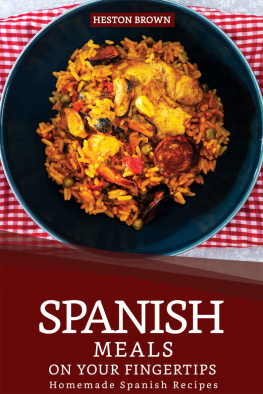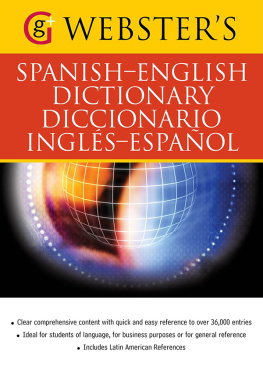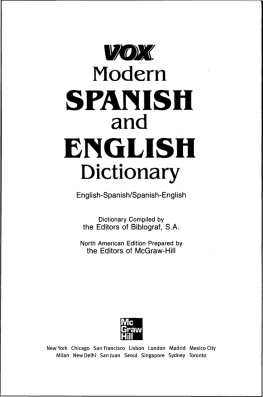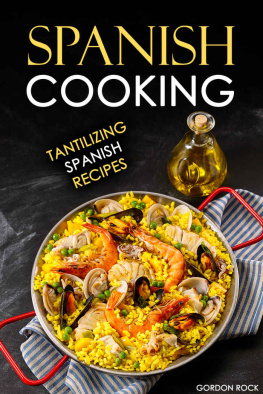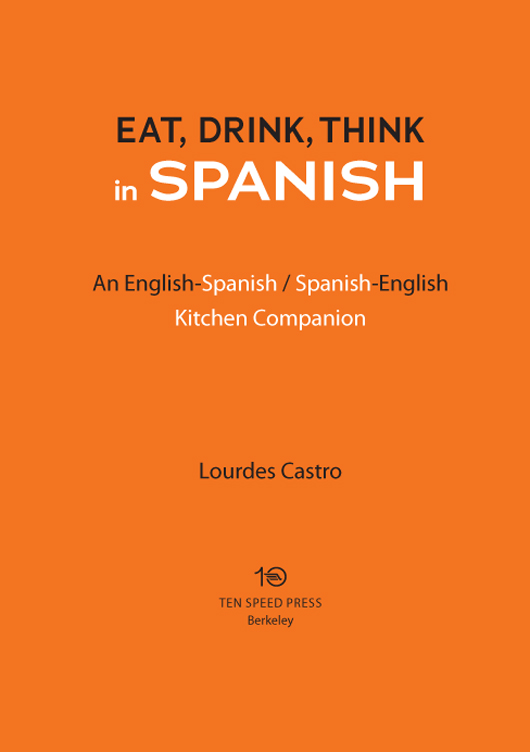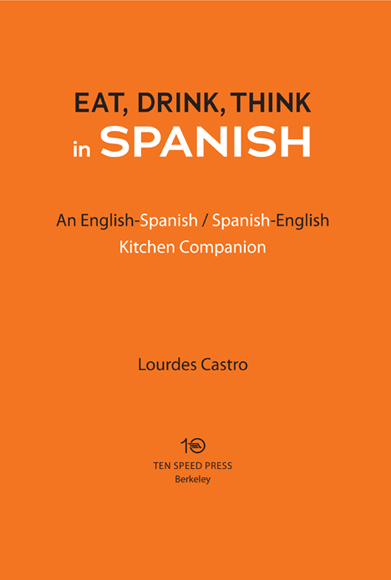To my late grandmother, Eva Rodriguez Cuetara, an extraordinary Spanish teacher whose love of the language was contagious.
INTRODUCTION
Necessity, who is the mother of invention.
Plato, The Republic
A few years ago, I was asked by organizers of an event for the James Beard Foundation to serve as a translator for famed Spanish chef Juan Mari Arzak. I was to sit next to chef Arzak during a dinner cooked by several of Spains brightest culinary stars. My responsibility was simplehelp him navigate the media and offer assistance with dinner guests who did not speak Spanish.
In the process of working out the logistics for a dinner cooked by seven foreign-based chefs, it became evident to the organizers that they needed help communicating with the Spanish chefs. Specific ingredients needed to be sourced and equipment ordered. As a native Spanish speaker, I stepped in as a liaison.
The menus were intricate, and, before I knew it, I was mentally searching for the English word for cigalas and percebes while at the same time coming up with the Spanish word for fennel and pigs cheeks. I had anticipated issues with regional ingredients but I had taken for granted that these items would have a readily available English translation.
A few months after the Spanish dinner, I was presented with another priceless experience: I was asked to serve as a personal translator for renowned Australian chef Tetsuya Wakuda during his weeklong stay in Madrid for a culinary conference. Talk about a reversal of fortune. This time I was to pair my American English with Chef Wakudas Australian dialect, and then use my Cuban Spanish to translate the information for Spaniards. If there was ever a need for a Spanish/English dictionary of culinary terms, that was it.
One Language for Many Cultures and Cuisines
While the differences in vernacular among Spanish-speaking countries are well known among native speakers, the divergence is not often recognized by those new to the language. And never is this more apparent than when speaking of food. Not only does each Latin American country have its own cuisine and culinary history, the words used to refer to ingredients, equipment, and technique vary among the countries. Take a banana, for example: the fruit may be referred to as pltano, cambur, banano, or gineo, depending on what country one is from.
Eat, Drink, Think in Spanish was written as a tool to help English and Spanish speakers communicate more effectively regarding matters of gastronomy. I outline the various Spanish words used to refer to an ingredient, provide phonetic pronunciations, and touch on country specific terms and national dishes.
To bring order to all this information, the book was compiled and organized in a specific manner. The following notes will help you navigate the dictionary and get the most out of its information.
Notes for Using this Book
This book is divided into two parts. The first half of the book lists terms alphabetically in English, followed by the Spanish translation. The second half of the book lists terms alphabetically in Spanish, followed by the English translation. All entries contain the following: term name, translated term, Spanish phonetic pronunciation, term category (see below), and the definition.
TERMS
About two thirds of the terms have both English and Spanish names (i.e. water/agua), which are found in both parts of the book and are easily cross-referenced. You will also see cases where the terms are cognates, with the same word serving in both languages. Ive included entries for these terms because it would not be readily apparent otherwise that they are cognates. The remaining terms do not have English translations (i.e. fajita, chimichurri, tortilla); such words are found only in the Spanish-English part of the book.
Some terms have more than one Spanish translation. For example, peach can be referred to interchangeably as durazno or melocotn. In these cases, you will see multiple Spanish words listed with the English term in the English-Spanish part of the book. However, the Spanish-English part includes entries for each of the Spanish synonyms; I encourage you to use those entries to help you select the most appropriate translation.
In some cases, the translation depends on the form of the wordwhether its used as a noun or a verb. You will see definitions for each form in such entries. Lastly, like most reference books, similar terms are grouped together: for example, the many varieties of beans are listed as bean, green, bean, navy, bean, pinto. Likewise, cuts for specific types of meat follow the main entry for that type of meat; you will find sirloin steak listed under Beef, sirloin.
CATEGORIES
As a way of helping you further understand the meaning of a term, all terms are identified under one of the following categories: Baking & Pastry, Beverage, Condiments, Cooking Method/Technique, Descriptor, Dish, Equipment, Fish & Shellfish, Fruit & Vegetables, Game, General, Grains & Cereals, Herbs & Spices, Meat, and Nuts & Oils.
Categories are especially helpful with terms that have multiple meanings. For example, whisk can either refer to a kitchen tool (agitador) or a technique (batir). In these cases, both definitions will be listed in the entry for whisk, with each definition accompanied by its Spanish translation and category.
Whisk Agitadorah-hee-tah-DOHR
EQUIPMENT Definition text.
Batirbah-TEER
COOKING METHOD/TECHNIQUE Definition text.
SPANISH WORDS WITHOUT AN ENGLISH TRANSLATION
Most Spanish terms that do not have an English translation are country specific, meaning that they are words used to describe a Spanish speaking countrys national or typical dish, or its indigenous ingredients. In these cases, the country is listed in parentheses next to the term. For example, chimichurri is a raw oil-based sauce made with lots of parsley. It is commonly served alongside meat in Argentina. It is also the name of a similar style sauce served in Nicaragua. This entry appears as follows:
Chimichurrichee-mee-CHOO-rree
CONDIMENT (Argentina) Definition text.
(Nicaragua) Definition text.
Pronunciation Guide
All Spanish terms are directly followed by a phonetic pronunciation. Keep the following in mind when pronouncing Spanish words:
| Vowel | Sounds like | As in |
| A | ah | Father |
| E | eh | Bet |
| I | ee | Beer |
| O | oh | Coat |
| U | oo | Food |
Accented syllables are capitalized. For example, the pronunciation for tequila is written teh-KEE-lah.
Syllables for a single word are connected with hyphens. The phonetic pronunciation of two words are separated by a space. For example, chile jalapeo is written


